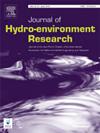In recent years, saltwater intrusion in river estuaries has become more severe and frequent worldwide. The common reasons lie in increasing freshwater withdrawal, river flow regulation and sea level rise due to global warming. In particular, the Red River Delta in northern Vietnam is facing a strong population growth worsening the pressure on freshwater resources for drinking water and irrigation needs. During the dry season, increasing conflicts and constraints in freshwater availability have already been experienced. Adverse combinations of river flow regulations and high sea levels lead to severe upstream propagations of salinity. This study takes advantage of a statistical characterization of discharges released from Hoa Binh reservoir and observed at Son Tay station, the main river flow control upstream of the river delta, along with downscaled and updated sea level rise scenarios to estimate the future extents of saltwater intrusion under different options of water release from reservoirs in the dry season. To do so, a 1D hydraulic model of the river delta network was implemented using MIKE11 software. The hydraulic and the quality modules were calibrated and validated with respect to the present scenario by using water stages and salinity concentrations observed in estuary branches. Sea level rise projections for 2050 and 2100 referred to RCP4.5 and RCP8.5 AR5 emission scenarios were then considered. Results show that river flow regulation can provide an effective mitigation measure. A 20–30% increase in the discharge released from the Son Tay station would be beneficial to push downstream the saltwater intrusion in the main Red River branch during the dry season. For instance, in 2050 the 1‰ salt concentration front is expected to be pushed back at least 6 km when the exceeding probability of the discharge released by Son Tay station decreases from 95% to 25%.


